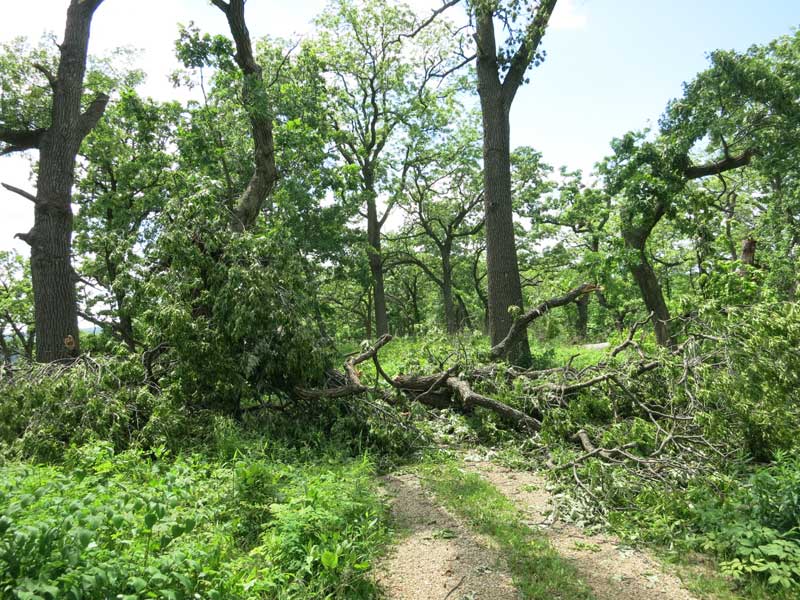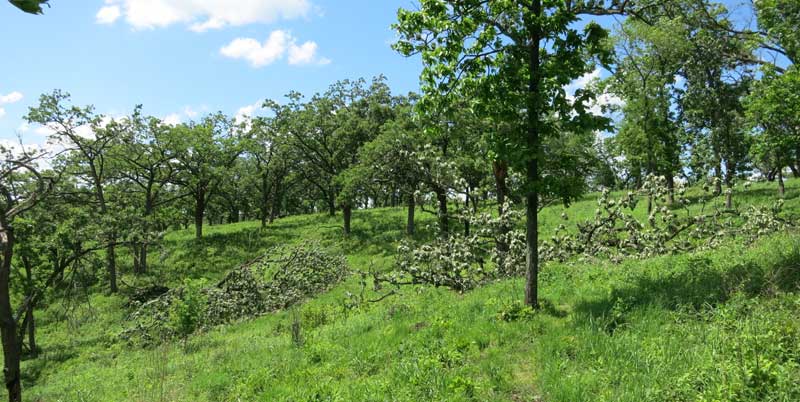Windthrow in oak savannas: an important factor in maintaining the savanna habitat?
Although the term “savanna” has been defined in various ways
(Scholes and Archer, 1997), for the present discussion a savanna is considered
a wooded area with herbaceous groundlayer (or understory) in which the trees
are sufficiently far apart so that they are open grown (Leach and Givnish,
1998). Note that this definition specifically does not mention grass as the groundlayer, although most
savannas have an extensive grass component.
The origin and dynamics of savannas have been subject to
extensive discussions throughout the world. Disturbance factors are generally
considered to be essential for the creation of savannas, of which the most
important factors mentioned have been climate (weather), herbivory, and fire. Windthrow is generally not mentioned for savannas, although it is extensively discussed in the forestry and
silviculture literature.
In this blog post, I would like to report on a number of
windthrow events in the bur oak savanna at Pleasant Valley Conservancy and
suggest that windthrow may be an important factor in maintaining the open character
of the oak savanna.
Background information on windthrow in the Upper Midwest was
obtained from an extensive review paper by Steil, Blinn, and Koka (2009). They
expressed wind disturbance in the following: “Wind moving over a closed,
relatively smooth canopy is fairly stable and causes minimal disturbance….When
an area of forest is clearcut [e.g.; open], the remaining forest edge of the
clearcut [open area] presents an abrupt obstruction to the wind….Wind
approaching the forest edge has a higher velocity than in an intact forest
because of the frictional boundary….Although damage…is often high…it does not
occur randomly.”
Factors affecting windthrow (from Steil et al. 2009)
|
Tree species
|
Oaks are among the most resistant
|
|
Diameter at breast height
|
Increased susceptibility with increasing dbh (except
possibly for the very largest trees)
|
|
Tree density
|
Neighboring trees protect and reduce the probability of
wind damage; the more open the canopy, the more susceptible to wind
disturbance
|
|
Aspect
|
Most damage occurs on sides facing prevailing wind; southwest or northwest
|
|
Topography
|
Wind speed highest at hilltop; wind damage most severe at
hilltop
|
|
Soil depth and rooting depth
|
Rooting depth an important factor; shallow rooted trees
more likely to be uprooted
|
Windthrow at Pleasant
Valley Conservancy.
Over the approximately 20 years that we have been monitoring
this area, we have lost a number of trees due to windthrow (probably no more than a few percentage). The windstorm of
May 28 2016 was especially severe, and prompted a consideration of its
significance. The most serious damage was at the topographic top of the west
end of the ridge, as would be predicted from the data in the table. This area
contains primarily bur oaks, although there were also some hickories and large
black oaks that were affected (see photos below).
Two fairly large bur oaks were completely uprooted, exposing
their roots. These were growing in quite rocky soil at the edge of the south
firebreak, and because of the geology and soil, were undoubtedly shallowly
rooted. Some of the bur oaks on the top of the ridge lost fairly good-sized
branches, but did not loose enough leafage to kill them. A number of hickories
lost their whole tops, and will probably die. Some cherries were also lost. One
very large black oak at the top of the ridge lost almost all of its top and
will probably die (see photos).
About 10 years ago we had a straight-line wind that took
down at least five large black oaks that had died or were in the process of
dying from oak wilt. Some of these still remain standing as snags, although
they are gradually succumbing to fire damage.
Our observation is that trees in the open, such as those in the
savanna, are more likely to suffer from windthrow than trees in the closed
forest in the North Woods. This agrees with the information from Steil et al.
Hypothesis
Open-grown oaks, especially those on ridge tops, are more
sensitive to windthrow. Over the long life time of these savanna oaks, it is
likely that some of these oaks will be uprooted or severely damaged. The bigger
the tree, more likely it will be damaged by windthrow, up until the largest
size.
There should be a positive feedback effect. Windthrow will create openings and openings are more sensitive to windthrow. Once a portion of forest is opened up by windthrow, trees in the open will start growing as "savanna" trees. Given a long enough
period of time, there may be a steady state condition, creating an open savanna
habitat.
Although this discussion is on oak savannas, windthrow may
be significant in savannas in other parts of the world where the trees are not oaks.
 |
| Most of the top of a black oak ended up on the woods road. Fortunately, the ancient bur oak nearby was not hit. |
 |
| This large hickory lost all of its top and will probably not survive. 100 years is about the oldest that hickories survive. |
 |
| Two medium-sized bur oaks along the crest of the hill were shallow-rooted and were uprooted. |
 |
| This bur oak lost about half of its wood but will probably survive. |
Leach, Mark K. and Givnish, Thomas J. 1998. Identifying
highly restorable savanna remnants. Transactions
Wisconsin Academy Sciences, Arts and Letters 86: 119-128.
Scholes, R.J. and Archer, S.R. 1997. Tree-grass interactions
in savannas. Annual Review of Ecology and
Systematics 28: 517-544.
Steil, Jeremy C., Blinn, Charles R., and Kolka, Randy. 2009.
Foresters’ perceptions of windthrow
dynamics in Northern Minnesota riparian management zones. Northern Journal
of Applied Forestry 26: 76-82.


0 Comments:
Post a Comment
Subscribe to Post Comments [Atom]
<< Home